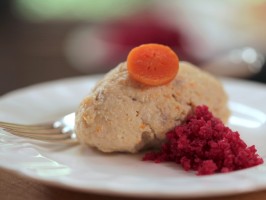As HG savored the last of the delicious gefilte fish (brought by visiting Peter Hellman from Zabar’s,the famous New York gourmet emporium), HG contemplated the wonders of chopped and poached fish. Memory was sharpened by a few snifters of icy Aakavit (the wonderful 84 proof Danish response to vodka) and chasers of dark ale. Zabar’s product matched in flavor and succulence the gefilte fish produced by HG’s late Mom in her Bronx kitchen. Mom chopped fresh water fish: whitefish, pike, carp and “buffel” (curious HG learned that “buffel” was Ictiobus, often called Buffalo fish). Mom mixed the fish with matzo meal, eggs and grated onion. Formed the mix into ovals and poached them in a broth flavored by fish heads, bones and skin. The fish heads, etc. were removed before poaching and the broth was strained and served with cooked carrots and onions. Her gefilte fish were served warm or cold. They were always decorated with slices of carrot. Very strong, freshly grated horseradish was obligatory. Chunks of Challah were dunked in the warm fish broth. If cold, the broth turned gelatinous (still delicious with Challah). “Gefilte” means stuffed. Eastern European Jews stuffed the chopped fish into the skin of a fish. Made one fish go a long way. “Galitzianers” (Jews from Galicia, the borderland between Poland and the Ukraine) added sugar to the chopped fish mix. Mom considered this a culinary obscenity. Excellent gefilte fish was served in New York’s many “dairy” restaurants (Alas, only a few still exist.) If your gefilte fish experience has been confined to the bottled supermarket product, you don’t know what pleasure you have been missing. Order the real stuff from Zabar’s online. Similar to gefilte, Chinese fish balls are an omnipresent street food in Hong Kong and in Chinese restaurants throughout New York. HG ate them often at Congee Noodle House when HG/BSK had a loft (and later a townhouse) in the Mt. Pleasant neighborhood of Vancouver. The fish balls are usually made of mackerel, corn starch, salt and pepper. After being chopped in a food processor, the mix has to be slammed on a plastic cutting board about 50 times before poaching (Good way to relieve stress). The slamming creates a unique springy texture. No surprise, the ultimate chopped fish treat can be found in France: Quenelles in Sauce Nantua, chopped pike ovals in a sauce of fresh crayfish and cream. These are a specialty of Lyon. The chopped fish is mixed with flour, eggs and loads of butter (of course). Best place in Paris for this lush dish Moissonnier, a Lyonnaise restaurant in the Fifth Arondissement. The portions in this bistro are enormous. Come hungry.
Chopped And Poached Delights
April 18th, 2016 § 0 comments § permalink
Gefilte Fish
August 12th, 2014 § 0 comments § permalink
HG misses a champion quality warm weather dish: the Gefilte Fish prepared by HG’s late Mom. Often maligned due the rubbery, jellied, mass produced version served from a jar on Jewish holidays, Gefilte Fish means “stuffed fish.” But, this is misleading. The Gefilte Fish that we have come to know consists of chopped freshwater fish combined with matzo meal, eggs, grated onion and white pepper. This forcemeat is formed into balls, poached in strong fish broth and served cold with the jellied broth and strong horseradish — essentially a Jewish quenelle. Egg bread (challah) is the appropriate accompaniment. Little HG often acted as Mom’s sous chef in the preparation of Gefilte Fish. HG grated onion and horse radish and tried not to inhale the pungent fumes or scrape his knuckles on the box grater. Removed the fish heads and bones from the fish stock and dumped them in the garbage can. HG’s Mom chopped four varieties of fish — carp, pike, whitefish and buffel. This last fish, buffel, was a mystery to little HG. Years later HG learned this was a reference to Buffalo Fish. Buffel was the Yiddish translation (or Yinglish). These days Buffalo Fish can only be found at fishmongers in New York’s Chinatown. HG’s Mom used a high proportion of carp. This gave her fish balls a richer flavor and a much darker color than most other versions. Carp is native to China and was brought to Europe in the 17th Century by Jewish traders (and others) working the silk routes. Jews began cultivating carp in special ponds and it quickly became a significant holiday dish in Eastern European homes both Jewish and Gentile. Its popularity spread and “Carpe a la Juive” (jellied carp prepared in the Jewish style) rated four entries in France’s encyclopedic Larousse Gatronomique. HG’s Mom often prepared it. Not an HG favorite. HG preferred her rich and velvety Gefilte Fish — a humble and delicious dish with a sullied reputation.

